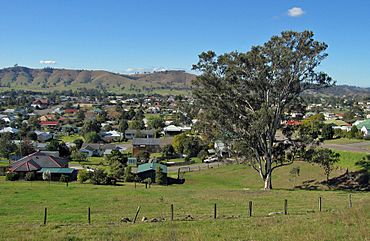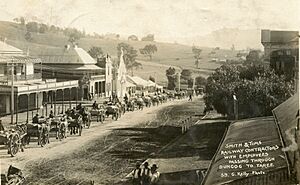Dungog, New South Wales facts for kids
Quick facts for kids DungogNew South Wales |
|||||||||||||||
|---|---|---|---|---|---|---|---|---|---|---|---|---|---|---|---|

View of Dungog from Hospital Road
|
|||||||||||||||
| • Density | 7.31/km2 (18.9/sq mi) | ||||||||||||||
| Established | 1972 | ||||||||||||||
| Postcode(s) | 2420 | ||||||||||||||
| Elevation | 61 m (200 ft) | ||||||||||||||
| Time zone | AEST (UTC+10) | ||||||||||||||
| • Summer (DST) | AEDT (UTC+11) | ||||||||||||||
| Location |
|
||||||||||||||
| LGA(s) |
|
||||||||||||||
| Region | Hunter, Mid North Coast | ||||||||||||||
| County | Durham | ||||||||||||||
| Parish | Dungog | ||||||||||||||
| State electorate(s) | Upper Hunter | ||||||||||||||
| Federal Division(s) | Lyne | ||||||||||||||
|
|||||||||||||||
|
|||||||||||||||
Dungog is a country town in New South Wales, Australia. It's located on the Williams River in the Hunter area. Dungog is known for its dairy farms and timber industry. It's the main town of the Dungog Shire local government area.
In 2021, about 2,169 people lived in Dungog. A small part of the town is also in the Mid-Coast Council area. The Fosterton Loop, a 22-kilometre (14 mi) road, is used for the yearly Pedalfest event.
Contents
History of Dungog
Who lived in Dungog first?
The original people of the Dungog area are the Gringai clan. They are part of the Wonnarua people, an Aboriginal Australian group.
How Dungog started
In the early 1800s, explorers and surveyors started mapping the area. By the 1830s, a small settlement called Upper William began to grow. It was named Dungog in 1838, which is a local Gringai word. The town quickly got a court house, a lockup, and places like inns and shops.
Early landowners like Dowling, Mackay, and Hooke had streets named after them. Their families still live in the area today. In 1846, Dungog had only 25 houses. By 1854, there were four hotels, and two of them are still open today!
Growing the town
The town's original plan from 1838 gave people lots of space for their homes and even paddocks for animals. For a long time, Dungog was mostly open land with a few houses.
Dungog grew much faster after the 1890s, thanks to the dairy industry. When the railway arrived in 1911, it helped the town grow even more. Many beautiful homes and shops you see today were built around this time. Modern services like water and electricity also made Dungog a great place to live.
In the 1920s, the main street, Dowling Street, was improved. New businesses and money came into the town. Even during World War II, Dungog saw new buildings, including a large new Royal Hotel and several new homes.
Since the 1950s, not many new public buildings have been built. However, many new homes have appeared. While dairy farming has become less common, beef farming is still important. Today, many visitors come to Dungog to enjoy its beautiful nature. People who love the countryside have also bought and fixed up many old homes in the area.
Historic Places in Dungog
Dungog has several places that are listed for their historical importance:
- The Cooreei Bridge over Williams River at 101 Main Road.
- The Dungog Courthouse and Residence on Lord Street.
- The Dungog Picture Theatre (James Theatre) at 6 Brown Street.
Dungog's Weather
Dungog has a mild humid subtropical climate. This means it has warm summers and cool winters.
| Climate data for Chichester Dam, 1938–1956 | |||||||||||||
|---|---|---|---|---|---|---|---|---|---|---|---|---|---|
| Month | Jan | Feb | Mar | Apr | May | Jun | Jul | Aug | Sep | Oct | Nov | Dec | Year |
| Mean daily maximum °C (°F) | 26.2 (79.2) |
24.9 (76.8) |
23.3 (73.9) |
20.2 (68.4) |
17.4 (63.3) |
14.2 (57.6) |
13.7 (56.7) |
15.5 (59.9) |
19.1 (66.4) |
21.4 (70.5) |
24.1 (75.4) |
26.6 (79.9) |
20.6 (69.1) |
| Mean daily minimum °C (°F) | 16.7 (62.1) |
16.7 (62.1) |
16.2 (61.2) |
12.7 (54.9) |
9.7 (49.5) |
7.0 (44.6) |
6.2 (43.2) |
6.9 (44.4) |
9.8 (49.6) |
12.1 (53.8) |
14.9 (58.8) |
17.2 (63.0) |
12.2 (54.0) |
| Average precipitation mm (inches) | 161.9 (6.37) |
180.9 (7.12) |
173.6 (6.83) |
101.3 (3.99) |
91.9 (3.62) |
103.8 (4.09) |
52.1 (2.05) |
59.4 (2.34) |
61.1 (2.41) |
90.8 (3.57) |
106.5 (4.19) |
124.8 (4.91) |
1,311.3 (51.63) |
| Average precipitation days | 12.4 | 13.0 | 13.2 | 10.4 | 10.5 | 11.4 | 9.4 | 8.4 | 8.4 | 10.3 | 11.1 | 11.7 | 130.2 |
People of Dungog
How many people live in Dungog?
In 2021, the population of Dungog was 2,169 people.
Where are people from?
- About 9.5% of the people are Aboriginal and Torres Strait Islander people.
- Most people (90.8%) were born in Australia.
- Other common birthplaces include England (1.6%), Germany (0.4%), and Scotland (0.4%).
What languages do they speak?
- Most people (95.1%) speak only English at home.
- A small number speak other languages like Afrikaans or Mandarin.
What are their religions?
- Many people (33.2%) said they had No Religion.
- Other common religions include Anglican (23.7%) and Catholic (17.5%).
| Historical population | ||
|---|---|---|
| Year | Pop. | ±% |
| 1921 | 1,770 | — |
| 1933 | 2,128 | +20.2% |
| 1947 | 2,041 | −4.1% |
| 1954 | 2,154 | +5.5% |
| 1961 | 2,211 | +2.6% |
| 1966 | 2,101 | −5.0% |
| 1971 | 2,122 | +1.0% |
| 1976 | 2,175 | +2.5% |
| 1981 | 2,126 | −2.3% |
| 1986 | 2,106 | −0.9% |
| 1991 | 2,187 | +3.8% |
| 1996 | 2,181 | −0.3% |
| 2001 | 2,116 | −3.0% |
| 2006 | 2,102 | −0.7% |
| 2011 | 2,132 | +1.4% |
| 2016 | 2,159 | +1.3% |
| 2021 | 2,169 | +0.5% |
| Source: Australian Bureau of Statistics data. | ||
Culture and Events
Dungog hosts many fun events that bring tourists to the area. These include:
- The Dungog Film Festival (now part of the Dungog Festival)
- The Dungog Agricultural Show
- Pedalfest
- The Dungog Rodeo
- The Thunderbolt Rally
These events show off local products and talents.
James Theatre: Australia's Oldest Cinema
Dungog is home to the James Theatre, which is the oldest movie theatre in Australia that has been running continuously. It's located at 6 Brown Street. This theatre shows new movies soon after bigger cities.
The Dungog Film Society also uses the cinema. They show special films each month and host events like Flickerfest. The theatre is also where the Dungog Film Festival used to be held.
The James Theatre first opened in December 1912. It started as an open-air theatre and was later covered. In 1930, it was rebuilt to show "talkie" movies and have a better dance floor. The theatre's design is special because it's one of only four in New South Wales with a Spanish Mission Style look. The local council has owned the theatre since 1979.
Dungog Film Festival
The Dungog Film Festival started in 2007. It was a film festival that aimed to help local tourism and show off Australian movies. It ran for four days, and some of the money helped to keep the James Theatre going. The festival was held every May and only showed films by Australian filmmakers.
The film festival stopped in 2013. In 2014, it was replaced by a bigger arts event called the Dungog Festival, which now happens every October Long Weekend. The State Government helped fund the festival for three years. As of 2024, the original Dungog Film Festival is no longer active. Movies were shown at places like the James Theatre and the RSL hall.
Gentlemen of the Road Music Festival
On October 20, 2012, Dungog hosted the 'Gentlemen of the Road' music festival. This was a special event organized by the band Mumford and Sons. They chose a small town in each country they toured to hold a one-day music festival. It featured local artists and bands who were friends with Mumford and Sons.
The "Dungog Stopover" included popular artists like Husky, Matt Corby, Sarah Blasko, and Edward Sharpe and the Magnetic Zeros, with Mumford and Sons as the main act. Over 13,000 people came to the event at the town's showground. Many visitors stayed at campgrounds, while the bands stayed in local motels and pubs.
Education in Dungog
Dungog High School has about 680 students. Children from many nearby towns, such as Clarence Town, Gresford, and Paterson, come to this school.
Historical Society and Museum
The Dungog Historical Society started in 1963. It's located in the old School of Arts building, which also houses the Dungog Museum. The museum has a large collection that shows the history of Dungog. This includes information about local Aboriginal people and family histories.
The main exhibit is called Dungog: The Making of a Community. It tells the story of Dungog through different topics. The museum also has temporary exhibitions.
Train Travel
Dungog's train station has been part of the North Coast railway line since 1911. In 1926, a special train called the Great White Train visited, and many people came to see it. Today, there are several train services from Dungog each day, including local Hunter Line trains and long-distance NSW TrainLink XPT services.
Sports in Dungog
Dungog Soccer Club – "The Boomerangs"
Dungog is home to the Dungog Soccer Club, known as "The Boomerangs". They play in the Zone League competitions of the Northern NSW Football Federation. The club has a strong junior program with 10 teams playing in competitions across the Hunter Valley.
Other Sports
Dungog also has a Rugby League club called the Dungog Warriors, with junior and senior teams. There's also a Pony Club, a Cricket Club, and a Netball Association.
The town has six tennis courts used for children's coaching and school competitions. Many residents also enjoy horse riding and take part in local rodeos.
Famous People from Dungog
Here are some notable people who have connections to Dungog:
- Kevin Bacon – An Olympic equestrian (horse rider).
- Alyson Best – An actress.
- Tallis Duncan — A rugby league player.
- Reginald Golledge – A geographer (someone who studies the Earth's features).
- Henry Porter – A rugby league player and coach.
- Dave Sands – A famous Australian boxer who sadly died near Dungog in 1952.
- Tony Townsend – A rugby league player.
- Doug Walters – A cricketer.



